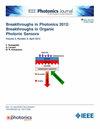Investigation on Circadian Regulation of Four-Primary LED Display Differed in People by GA
IF 2.1
4区 工程技术
Q3 ENGINEERING, ELECTRICAL & ELECTRONIC
引用次数: 0
Abstract
The concept of human-centric lighting is gradually emerging. People no longer only consider the lighting function of light, but also begin to pay attention to the comfort and health of light. In this article, we perform an investigation on the circadian regulation of four-primary light-emitting diode (LED) based displays for the people with various ages from 1 year old to 100 years old. The double-Gaussian function is used to mimic the spectral power distribution of monochromatic LED. The main figures of merit of LED display performance are color gamut of Rec. 2020, luminous efficacy of radiation, correlated color temperature (CCT), and also non-visual parameters, such as circadian stimulus and melanopic efficacy of luminous radiation provided by Commission Internationale de l'Eclairage (CIE) standard. Then, the genetic algorithm is adopted for performing the spectral optimization of four-primary LED display while many constraint conditions are set, such as CCT values (2700 K and 6500 K), CCT tolerance, and color distance (利用 GA 研究四原色 LED 显示屏对人的昼夜节律调节差异
以人为本的照明理念逐渐兴起。人们不再仅仅考虑光的照明功能,也开始关注光的舒适性和健康性。在本文中,我们研究了基于四基色发光二极管(LED)的显示屏对从 1 岁到 100 岁不同年龄段人群的昼夜节律调节。本文使用双高斯函数来模拟单色 LED 的光谱功率分布。LED 显示屏性能的主要参数包括 Rec.2020 色域、辐射光效、相关色温(CCT),以及非视觉参数,如昼夜节律刺激和国际照明委员会(CIE)标准规定的光辐射黑色素效应。然后,在 CIE 1960 UCS 色彩空间中设置了许多约束条件,如 CCT 值(2700 K 和 6500 K)、CCT 容差和色距(Duv < 0.01),并采用遗传算法对四基色 LED 显示屏进行光谱优化。视觉和非视觉特性的相关结果也与三原色 LED 显示屏的结果进行了比较。这项工作将为针对不同年龄段人群开发健康的四基色 LED 显示屏铺平道路。
本文章由计算机程序翻译,如有差异,请以英文原文为准。
求助全文
约1分钟内获得全文
求助全文
来源期刊

IEEE Photonics Journal
ENGINEERING, ELECTRICAL & ELECTRONIC-OPTICS
CiteScore
4.50
自引率
8.30%
发文量
489
审稿时长
1.4 months
期刊介绍:
Breakthroughs in the generation of light and in its control and utilization have given rise to the field of Photonics, a rapidly expanding area of science and technology with major technological and economic impact. Photonics integrates quantum electronics and optics to accelerate progress in the generation of novel photon sources and in their utilization in emerging applications at the micro and nano scales spanning from the far-infrared/THz to the x-ray region of the electromagnetic spectrum. IEEE Photonics Journal is an online-only journal dedicated to the rapid disclosure of top-quality peer-reviewed research at the forefront of all areas of photonics. Contributions addressing issues ranging from fundamental understanding to emerging technologies and applications are within the scope of the Journal. The Journal includes topics in: Photon sources from far infrared to X-rays, Photonics materials and engineered photonic structures, Integrated optics and optoelectronic, Ultrafast, attosecond, high field and short wavelength photonics, Biophotonics, including DNA photonics, Nanophotonics, Magnetophotonics, Fundamentals of light propagation and interaction; nonlinear effects, Optical data storage, Fiber optics and optical communications devices, systems, and technologies, Micro Opto Electro Mechanical Systems (MOEMS), Microwave photonics, Optical Sensors.
 求助内容:
求助内容: 应助结果提醒方式:
应助结果提醒方式:


